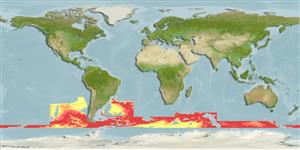Teleostei (teleosts) >
Perciformes/Zoarcoidei (Eelpouts and pricklebacks) >
Zoarcidae (Eelpouts) > Lycodinae
Etymology: Lycenchelys: Greek, lykos = wolf + Greek, enchelys, -yos = eel (Ref. 45335).
More on author: Regan.
Environment: milieu / climate zone / depth range / distribution range
Ecology
Marine; bathydemersal; depth range 3248 - 5320 m (Ref. 58018). Deep-water; 23°S - 63°S
Southern Ocean and Atlantic: Scotia Sea abyss and Peru-Chile Trench (Ref. 5197), Weddell Sea and the Crozet Plateau (Ref. 75765, 90064).
Size / Weight / Age
Maturity: Lm ? range ? - ? cm
Max length : 24.8 cm SL male/unsexed; (Ref. 11954)
Short description
Identification keys | Morphology | Morphometrics
Dorsal soft rays (total): 106; Anal soft rays: 95 - 112; Vertebrae: 117 - 138. This species differs form all other Southern Ocean congeners by having very large head pores and the retrograde origin of the dorsal fin (predorsal distance 27-36.6% SL, free dorsal-fin pterygiophores 6-16; pelvic fin present; anal fin rays 95-112; vertebrae 117-138 (Ref. 75765).
Life cycle and mating behavior
Maturity | Reproduction | Spawning | Eggs | Fecundity | Larvae
Anderson, M.E., 1990. Zoarcidae. p. 256-276. In O. Gon and P.C. Heemstra (eds.) Fishes of the Southern Ocean. J.L.B. Smith Institute of Ichthyology, Grahamstown, South Africa. (Ref. 5197)
IUCN Red List Status (Ref. 130435: Version 2024-2)
Threat to humans
Harmless
Human uses
Fisheries: of no interest
Tools
Special reports
Download XML
Internet sources
Estimates based on models
Preferred temperature (Ref.
123201): -0.3 - 1.7, mean 0.8 °C (based on 4494 cells).
Phylogenetic diversity index (Ref.
82804): PD
50 = 0.5000 [Uniqueness, from 0.5 = low to 2.0 = high].
Bayesian length-weight: a=0.00120 (0.00058 - 0.00248), b=3.10 (2.91 - 3.29), in cm total length, based on LWR estimates for this (Sub)family-body shape (Ref.
93245).
Trophic level (Ref.
69278): 3.4 ±0.5 se; based on size and trophs of closest relatives
Resilience (Ref.
120179): Low, minimum population doubling time 4.5 - 14 years (Preliminary K or Fecundity.).
Fishing Vulnerability (Ref.
59153): Low vulnerability (20 of 100).
